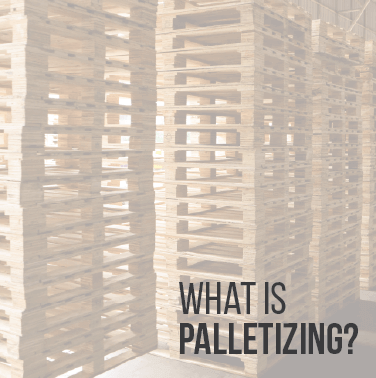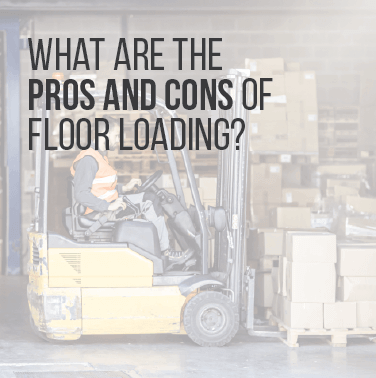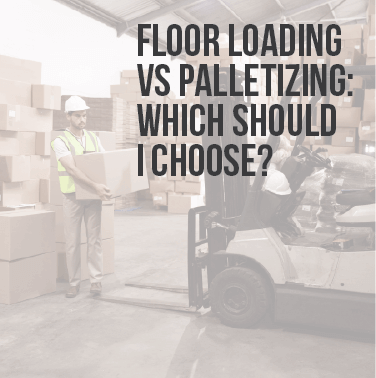Trailers and cargo containers can be filled with all kinds of freight. When it comes to loading freight, shippers typically stick to two primary methods: Floor loaded vs palletized. So which is right for you?
Floor-loaded freight is stacked from floor to ceiling without the use of a pallet. Palletized freight involves securing cargo to pallets that are loaded into a truck or container. Palletized shipping is better for speed and efficiency, while floor loading is geared toward cost savings and smaller freight.
In our article below, we have laid out more important details about floor-loaded freight and palletized shipping.
When freight is loaded onto the floor of a trailer and stacked toward the ceiling, it is called floor-loaded freight. Freight like this is considered “loose” since it is not secured by anything. You may also see it referred to as non-palletized freight.
Most floor-loaded shipments are full of packages that are too small to be secured by pallets. However, some floor load products are extremely large and awkwardly shaped.
These can include products like:
Floor loading isn’t as simple as piling boxes upon one another. Floor-loaded freight is stacked like a wall. Shipping companies require their warehouse workers to follow guidelines when they handle floor-loaded freight.
The guidelines for shipping companies are relatively the same. The guidelines companies keep for floor loaded freight is as follows:
The main reason for these guidelines is safety. An improperly loaded wall of floor-loaded freight could potentially fall on the person loading or unloading it.
Walls that are properly loaded are also safer for the packages themselves. Since they’re packed in tightly, it removes the possibility that they might bounce around or fall and break.

The process of palletizing is when cargo is wrapped up and secured to a pallet. Pallets are the wooden structures that cargo is stacked onto when it's shipped. Larger boxes tend to be secured to pallets as well as extremely fragile pieces of freight.
Just as with floor-loaded freight, palletized freight has its own unique style of loading that roughly all shipping companies use. Forklift operators follow these guidelines when they lift pallets:
Forklift procedures are used to ensure the safety of the forklift operator as well as warehouse workers nearby. These guidelines also ensure that the pallets and the freight they carry are not damaged either.
The main difference between floor loading freight and palletizing is that floor loading doesn’t utilize a pallet while palletized freight does. Another difference is that cargo loaded using the floor loaded method tends to fill the entire trailer, container, or vehicle that is transporting the freight.
The way that each type of freight is loaded is also different. Due to the weight of palletized loads, forklifts have to be used to move them across the warehouse and to load and unload them into whatever container is used for transport.
Floor-loaded freight is much lighter and is not always large enough to be secured by a pallet. Because of this, floor-loaded freight is instead loaded and unloaded by hand.

There are many different pros and cons to using floor loading freight that you should consider. If you want to save on shipping costs, then you should choose floor-loaded freight.
As we have already mentioned, floor-loaded freight can completely fill the trailer, container, or vehicle that it’s being transported in, whereas palletized freight cannot. That means with floor-loaded freight, you will be able to transport more freight with fewer shipments.
You will also save money that you would normally have to spend on pallets if you were shipping palletized freight. While you will save money on pallets and shipping, you will be paying more labor costs.
Floor-loaded freight is handled one package at a time by individual warehouse workers. This makes loading and unloading floor-loaded freight a much longer process. You also have to consider the amount of time it will take to load and unload large and unusual shipments like carpets, tires and other products.
Palletizing has its unique advantages and disadvantages as well. Pallets add more security for packages when they’re shipped. The pallets serve as a base for the packages to be secured which prevents them from falling and suffering further damage.
Pallets give extra protection for ocean freight shipments by slightly elevating them above the ground. That way, if any water does manage to get into the cargo container your packages will be just out of reach from the water.
Loading and unloading palletized freight is much less time-consuming and labor-intensive. Forklifts can efficiently lift and move palletized freight with ease.
Every time a pallet is moved, multiple packages move along with it. This is much more efficient than loading and unloading one package at a time like with floor-loaded freight.
The downside of using pallets is that they do not fill a cargo container or trailer as efficiently as floor-loaded freight. Despite being able to stack and secure multiple packages to its base, there will still be unused space in the container that transports them.
This means that you will be paying for empty space when you ship palletized freight. You will also be paying extra costs for the use of pallets.

There are trade-offs to both floor-loaded freight and palletized freight. The one that works best depends on how much time you have to ship and how much you're willing to spend on your shipments.
If time is of the essence and you are willing to spend more, then palletized freight is the best way to go. Palletized freight will ultimately cost you more than floor-loaded freight to ship. That said, palletized freight will be loaded and unloaded much faster.
Floor-loaded freight is a better option if time is more flexible for you. You will have to pay labor costs, but you won’t have to worry about making as many shipments if you're transporting numerous products as you would with palletized freight.
However, floor-loaded freight will take longer to be loaded and unloaded. Floor load is also a great method to use if the products you are shipping are too small to be secured by a pallet.
Amazon FBA, or fulfillment by Amazon, is very particular about how freight arrives at their warehouses. They prefer that freight arrives at their warehouse palletized.
While they will accept floor-loaded trailers, they have many rules as to how floor-loaded freight should be stacked. Not adhering to their guidelines could result in your shipment being refused.
Regardless of how you plan on shipping your freight, USA Truckload Shipping will get it there on time. We have numerous connections across the country that allow us to resolve any logistical challenges that face you and your shipment.
We ship virtually all kinds of items that you would ever need to transport, whether they require floor loading or palletizing. On our freight services page, you will find all the different forms of shipping we cover. This includes HAZMAT and refrigerated among many other types of shipments.
At USA Truckload Shipping, our goal is to make sure that you are satisfied with the services that we provide. Contact our team today and we can help you on your shipping journey.
R+L Global Logistics
315 NE 14th St., Ocala, FL 34470